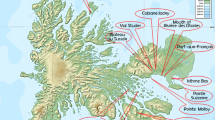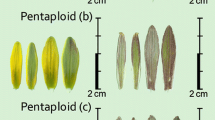Abstract
For the first time, genome size was determined from a total of 343 wild collected plants from the succulent genera Haworthia and Astroloba (Asphodelaceae: Alooideae). Genome sizes (2C values) turned out to be rather close, especially within genus Haworthia s.s. To improve the accuracy of the results, in the end 2,368 measurements were made. The measured nuclear DNA contents provide a further basis for the separation of Haworthia s.l. into three genera. This resulted in 69 recognized species of the new genera Haworthia, Haworthiopsis and Tulista. The 2C values for the largest genus Haworthia (=Haworthia subgenus Haworthia) with 45 species varies only from 21.7 to 24.7 pg. An exception is some accessions of Haworthia nortieri (var. agnis) with up to 27.2 pg. The four varieties of H. nortieri are here elevated to species level and placed in a new section Nortierae Zonn. The genus Haworthiopsis (=Haworthia subgenus Hexangulares) are clearly divided in two sections, each with 10 species: section Coarctatae (25.2–27.6 pg) and Venosae (28.9–33.6 pg). The highest value so far for Haworthia s.l. has been H. limifolia which is hexaploid with 99.8 pg. The third genus Tulista (=Haworthia subgenus QueryRobustipedunculares) with only four species varies from 35.9 to 37.2 pg. Closely related with Tulista also with respect to genome size is the genus Astroloba (including Poelnitzia) with nine species and from 30.4 to 34.0 pg. The results also show that most, but not all varieties are correctly attributed to the nominate species. A few varieties have been reinstated as species of which two have been renamed in Haworthiopsis. Further details are discussed in the main text. The genome sizes were compared with the genome sizes of all species of Gasteria, Chortolirion and 83 Aloe species. Aloidendron (=Aloe section Aloidendron) with 24.5–37.4 pg, comes out as the most basal in the published cladogram for the Alooidae. It leads to the interesting suggestion that the amount of nuclear DNA of the two species in section Kumara (=Aloe section Kumara) namely K. plicatilis (17.6 pg) and K. haemanthifolia (16.2 pg) and species in Aloiampelos (=Aloe section Macrifoliae; (21.6 pg) have decreased strongly, which is a rare phenomenon.



Similar content being viewed by others
References
Adams SP, Leitch IJ, Bennett MD, Chase MW, Leitch AR (2000) Ribosomal DNA evolution and phylogeny in Aloe (Asphodeleaceae). Amer J Bot 87(11):1578–1583
Bayer MB (1976) Haworthia handbook. National Botanic Gardens of South Africa, Cape Town
Bayer MB (1999) Haworthia revisited. A revision of the genus. Umdaus Press, Hatfield
Bayer MB, Manning JC (2012) The Haworthia nomenclator: a list of accepted species with some guidelines for infraspecific names. Haworthia Society (special edition)
Brandham PE, Carter S (1990) A revision of the Aloe tidmarshii/A. ciliaris complex in South Africa. Kew Bull 46(4):637–646
Brandham PE, Doherty MJ (1998) Genome size variation in Aloaceae, an angiosperm family displaying karyotypic orthoselection. Ann Bot(Oxford) 82(suppl A):67–73
Breuer I (1998) The world of Haworthias vol 1. Breuer I und Arbeitskreis für Mammillarienfreunde e.V.
Breuer I (1999) Summarized results of literature analysis of chromosome counting in the genus Haworthia. Haworthiad 13(3):88–93
Breuer I (2000) The world of Haworthias vol 2. Breuer I und Arbeitskreis für Mammillarienfreunde e.V.
Breuer I (2010) The genus Haworthia. Book 1. Alsterworthia International, London
Chase MW, De Bruijn AY, Cox AV, Reeves G, Rudall PJ, Johnson MAT, Eguiarte LE (2000) Phylogenetics of Asphodeliaceae(Asaparagales): an analysis of plastid rbcL and trnL-F DNA sequences. Ann Bot(Oxford) 86:935–951
Craib C (2005) Grass aloes in the South African veld. Umdaus Press, Hatfield
Cumming DM (2005) Chortolirion Berger: inferred relationship from limited hybridization. Alsterworthia Int 5(2):2–4
Cumming DW (2006) Poelnitzia Uitewaal: inferred relationships from limited hybridization. Alsterworthia Int 6–1:13–16
Cumming DW (2014a) Astroloba Uitewaal: inferred relationships from extensive hybridization. Alsterworthia International, London
Cumming DW (2014b) Haworthia Duval: inferred relationships from extensive hybridization. Alsterworthia International, London
Daru BH, Manning JC, Boatwright JS, Maurin O, Maclean N, Schaeffer H, Kuzmina M, van der Bank M (2013) Molecular and morphological analysis of the subfamily Alooideae (Asphodeliaceae) and the inclusion of Chortolirion in Aloe. Taxon 62:62–76
Doležel J, Bartos J, Voglmayer H, Greilhuber J (2003) Nuclear DNA content and genome size of trout and human. Cytometry 51a:127–128
Galbraith DW, Harkins KR, Maddox JM, Ayres NM, Sharma DP, Firoozabady E (1983) Rapid flow cytometric analysis of the cell-cycle in intact plant-tissues. Science 220:1049–1051
Govaerts R (2014) World Checklist of Haworthia. Facilitated by the Royal Botanic Gardens Kew. http://apps.kew.org/wcsp/. Accessed 10-2-2014
Grace OM, Klopper RR, Smith GF, Crouch NR, Figueiredo E, Ronsted N, van Wyk AE (2013) A revised classification of Aloe (Xanthorrhoeaceae subf. Asphodeloideae). Phytotaxa 76:7–14
Grime JP, Mowforth MA (1982) Variation in genome size—an ecological interpretation. Nature 299:151–153
Hayashi M (2001) Species concepts and taxonomic systems for the genus Haworthia. Haworthiad 15–1:4–21
Holland PG (1978) An evolutionary biogeography of the genus Aloe. J Biogeogr 5:213–226
Jacobsen H (1974) Lexicon of succulent plants. Blanford Press, London
Klopper RR, Smith GF, Figueiredo E, Grace OM, Van Wyk AE (2013) The correct names for species of Aloe sect. Chortolirion (Asphodelaceae: Alooideae). Taxon 62(2):1266–1267
Manning JC, Smith GF (2000) The genus Poelnitzia included in Astroloba. Bothalia 30:53
Manning JC, Boatwright JS, Daru BH, Maurin O, Van der Bank M (2014) A molecular phylogeny and generic classification of Asphodeliaceae subfamily Alooideae: a final resolution of the prickly issue of polyphyly in the alooids? Syst Bot 39:55–74
Roberts-Reynecke P (1965) The genus Astroloba Uitewaal(Liliaceae). M.Sc. Thesis, University of Cape Town, Cape Town
Rowley G (2013) Generic concepts in the Alooideae, Part 4 Haworthiopsis and Tulista: old wine in new bottles. Alsterworthia Int 13(3):6–13
Scott CL (2001) The genus Haworthia: a taxonomic revision. Aloe books, Johannesburg
Smith GF, Van Wyk BE, Steyn EM, Breuer I (2002) Infrageneric classification of Haworthia (Aloaceae): perspectives from nectar sugar analysis. Syst Geogr Plants 71:391–397
Suda J, Krahulcova A, Travnicek P, Krahulec F (2006) Ploidy versus DNA ploidy level: an appeal for consistent terminology. Taxon 55:447–460
Tiersch TR, Chandler RW, Wachtel SSM, Ellias S (1989) Reference standards for flow cytometry and application in comparative studies of nuclear DNA content. Cytometry 10:706–710
Treutlein J, Smith GF, Van Wyk BE, Wimk M (2003) Phylogenic relationships in Asphodelaceae (subfamily Alooideae) inferred from chloroplast DNA sequences (rbcL and matK) and from genomic fingerprinting (ISSR). Taxon 52(2):193–207
Uitewaal AJA (1947) A first attempt to subdivide the genus Haworthia based on floral characters. Desert Pl Life 19(9):132–136
Zonneveld BJM (2001) Nuclear DNA contents of all species of Helleborus discriminate between species and sectional divisions. Pl Syst Evol 229:125–130
Zonneveld BJM (2002) Genome size analysis of selected species of Aloe (Aloaceae) reveals the most primitive species and results in some new combinations. Bradleya 20:5–12
Zonneveld BJM (2009) The systematic value of nuclear genome size for all species of Tulipa L. (Liliaceae). Pl Syst Evol 281:217–246
Zonneveld BJM, Fritz GPJ (2010) Three species recognized in Chortolirion Berger (Asphodelaceae: Alooidae). Bradleya 28:27–36
Zonneveld BJM, Van Iren F (2001) Genome size and pollen viability as taxonomic criteria: application to the genus Hosta. Pl Biol(Stuttgart) 3:176–185
Zonneveld BJM, Van Jaarsveld EJ (2005) Taxonomic implications of genome size for all species of the genus Gasteria Duval (Aloaceae). Pl Syst Evol 251:217–227
Acknowledgements
The author thanks M.B. Bayer (South Africa), I. Breuer (Germany) and C. Grootscholten (The Netherlands) for their generous gifts of haworthias and astrolobas.
Author information
Authors and Affiliations
Corresponding author
Additional information
Dedicated to my friend Ton. Pullen†.
Rights and permissions
About this article
Cite this article
Zonneveld, B.J.M. Nuclear genome sizes of 343 accessions of wild collected Haworthia and Astroloba (Asphodelaceae, Alooideae), compared with the genome sizes of Chortolirion, Gasteria and 83 Aloe species. Plant Syst Evol 301, 931–953 (2015). https://doi.org/10.1007/s00606-014-1127-4
Received:
Accepted:
Published:
Issue Date:
DOI: https://doi.org/10.1007/s00606-014-1127-4




